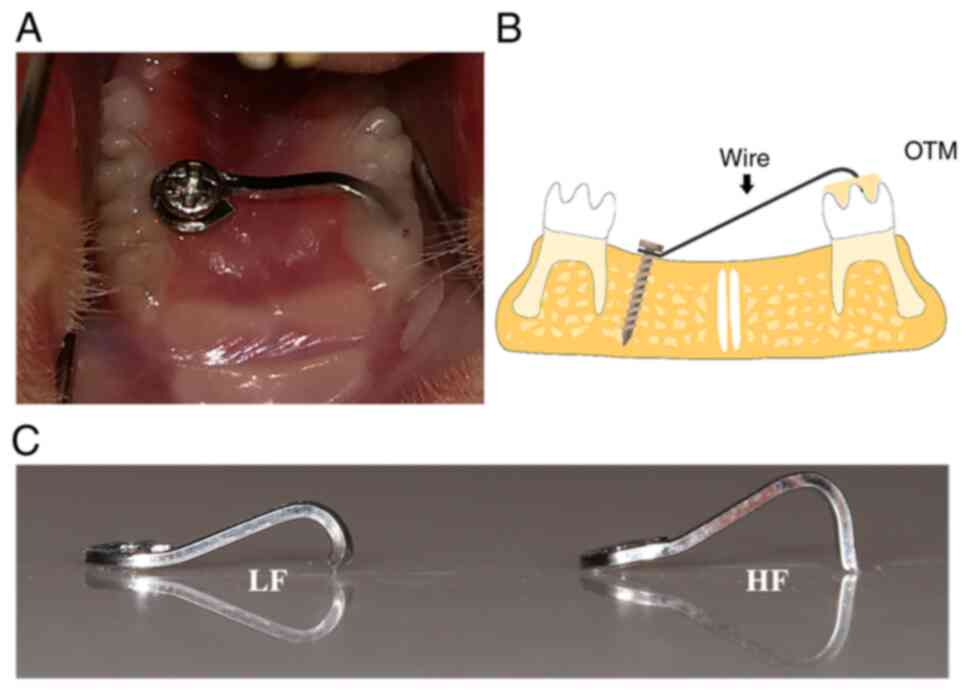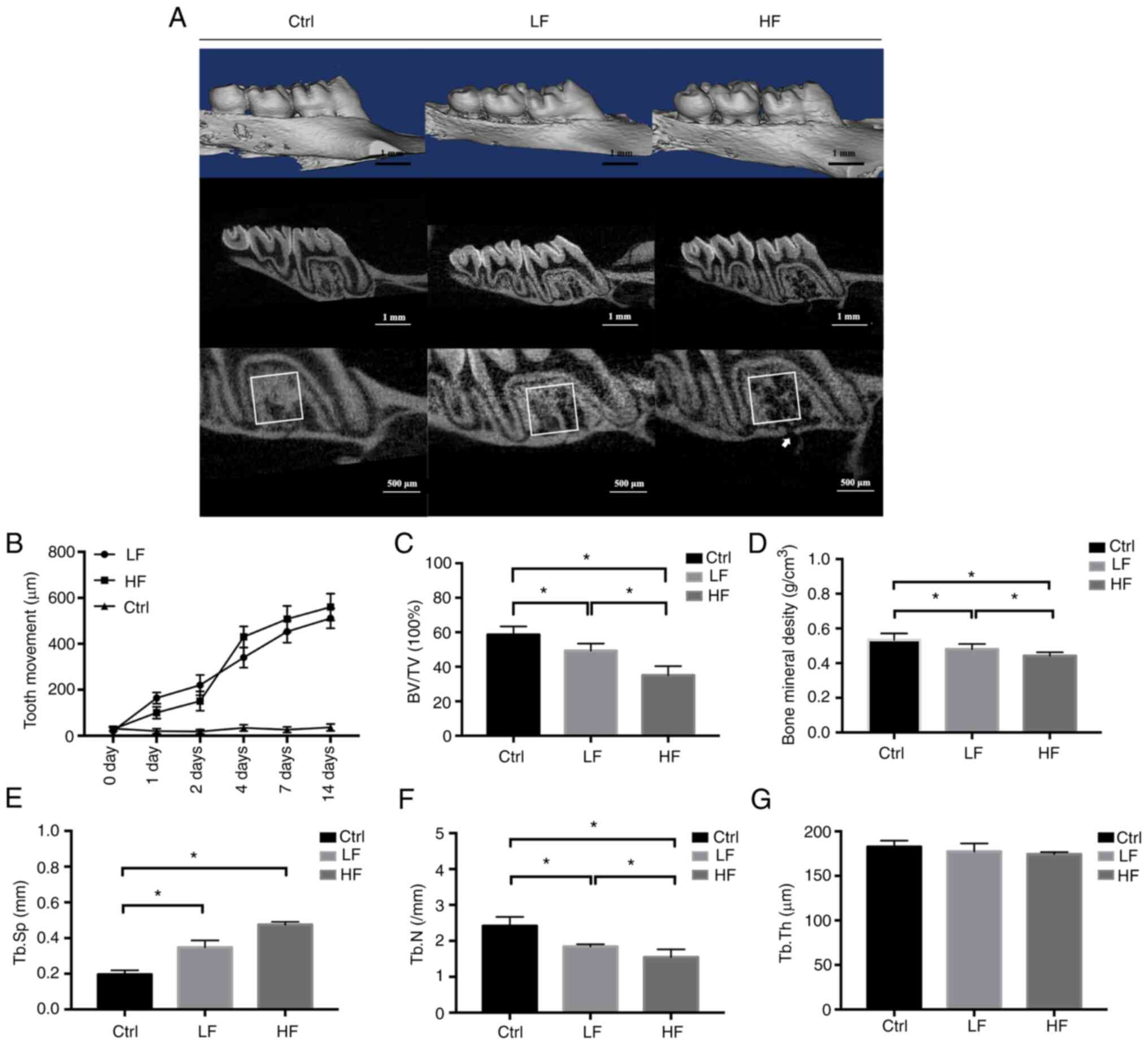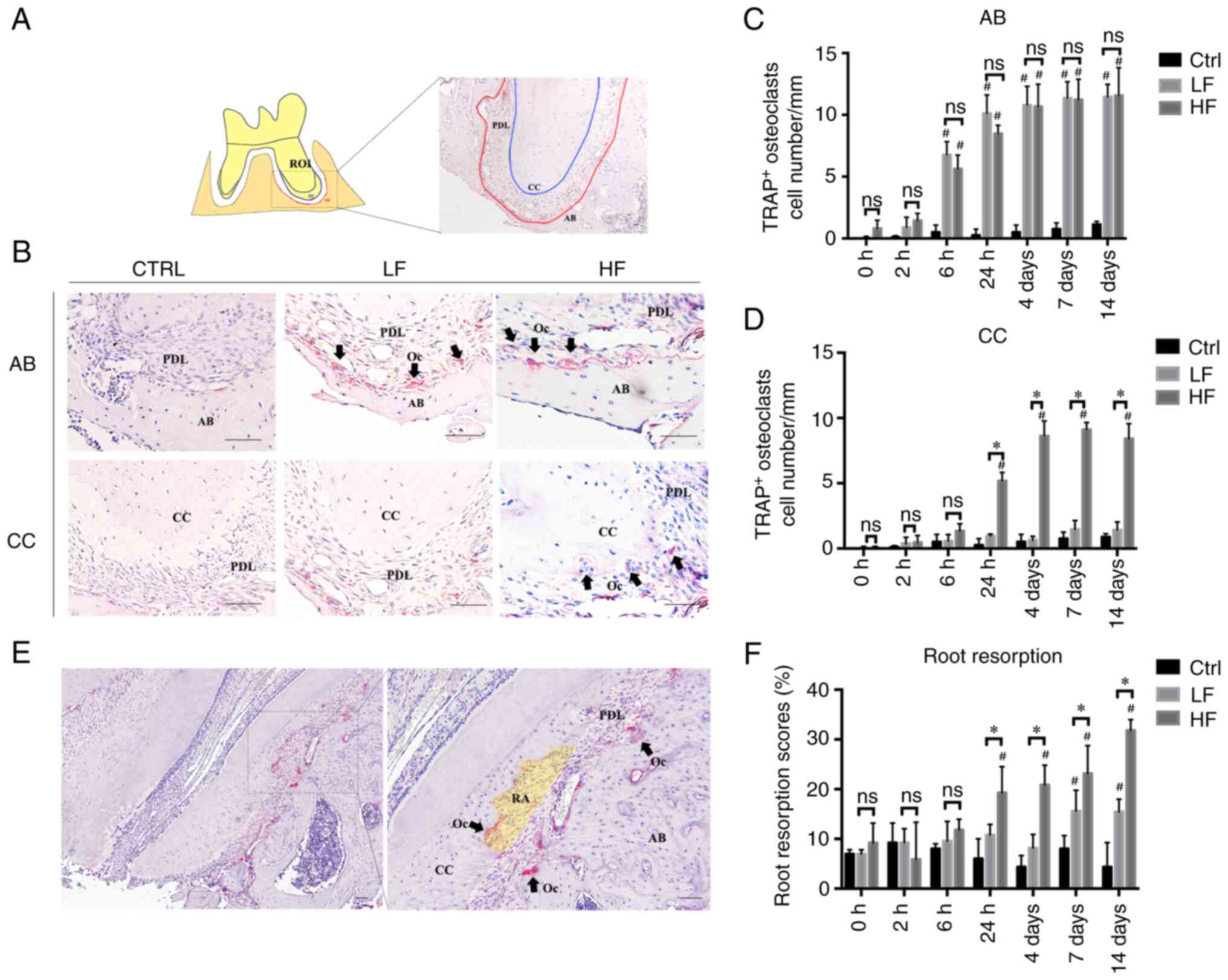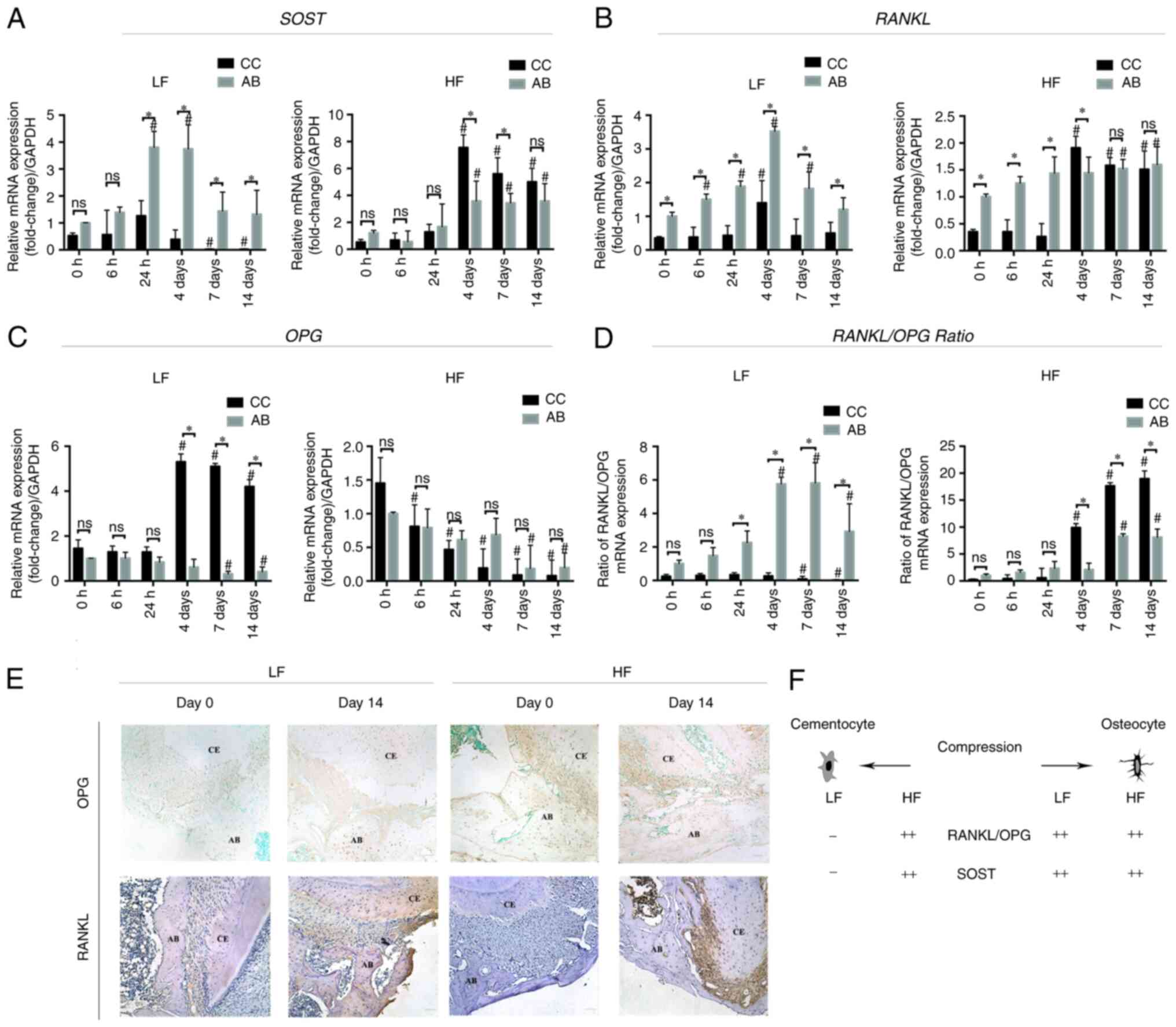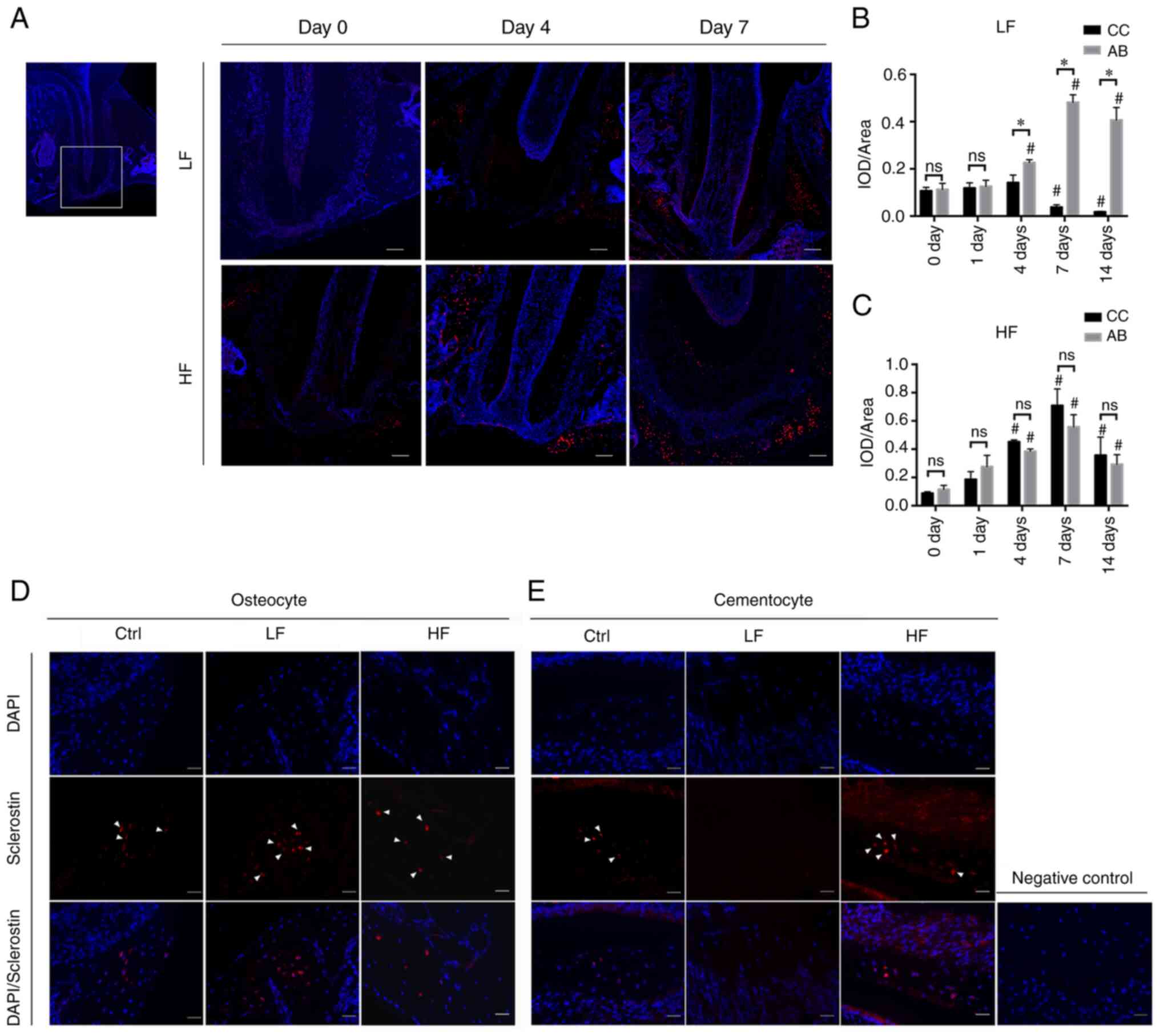|
1
|
Feller L, Khammissa RA, Thomadakis G,
Fourie J and Lemmer J: Apical external root resorption and repair
in orthodontic tooth movement: Biological events. Biomed Res Int.
2016:48641952016. View Article : Google Scholar
|
|
2
|
Ozkalayci N, Karadeniz EI, Elekdag-Turk S,
Turk T, Cheng LL and Darendeliler MA: Effect of continuous versus
intermittent orthodontic forces on root resorption: A microcomputed
tomography study. Angle Orthod. 88:733–739. 2018. View Article : Google Scholar : PubMed/NCBI
|
|
3
|
Gonzales C, Hotokezaka H, Yoshimatsu M,
Yozgatian JH, Darendeliler MA and Yoshida N: Force magnitude and
duration effects on amount of tooth movement and root resorption in
the rat molar. Angle Orthod. 78:502–509. 2008. View Article : Google Scholar : PubMed/NCBI
|
|
4
|
Ueda M, Kuroishi KN, Gunjigake KK, Ikeda E
and Kawamoto T: Expression of SOST/sclerostin in compressed
periodontal ligament cells. J Dent Sci. 11:272–278. 2016.
View Article : Google Scholar
|
|
5
|
Li Y, Zhan Q, Bao M, Yi J and Li Y:
Biomechanical and biological responses of periodontium in
orthodontic tooth movement: Up-date in a new decade. Int J Oral
Sci. 13:202021. View Article : Google Scholar
|
|
6
|
Wei T, Xie Y, Wen X, Zhao N and Shen G:
Establishment of in vitro three-dimensional cementocyte
differentiation scaffolds to study orthodontic root resorption. Exp
Ther Med. 20:3174–3184. 2020. View Article : Google Scholar : PubMed/NCBI
|
|
7
|
Lira Dos Santos EJ, de Almeida AB, Chavez
MB, Salmon CR, Mofatto LS, Camara-Souza MB, Tan MH, Kolli TN,
Mohamed FF, Chu EY, et al: Orthodontic tooth movement alters
cementocyte ultrastructure and cellular cementum proteome
signature. Bone. 153:1161392021. View Article : Google Scholar : PubMed/NCBI
|
|
8
|
Lira Dos Santos EJ, Salmon CR, Chavez MB,
de Almeida AB, Tan MH, Chu EY, Sallum EA, Casati MZ, Ruiz KGS,
Kantovitz KR, et al: Cementocyte alterations associated with
experimentally induced cellular cementum apposition in Hyp mice. J
Periodontol. 92:116–127. 2021. View Article : Google Scholar
|
|
9
|
Krishnan V and Davidovitch Z: On a path to
unfolding the biological mechanisms of orthodontic tooth movement.
J Dent Res. 88:597–608. 2009. View Article : Google Scholar : PubMed/NCBI
|
|
10
|
Borges de Castilhos B, Machado de Souza C,
Simas Netta Fontana ML, Pereira FA, Tanaka OM and Trevilatto PC:
Association of clinical variables and polymorphisms in RANKL, RANK,
and OPG genes with external apical root resorption. Am J Orthod
Dentofacial Orthop. 155:529–542. 2019. View Article : Google Scholar : PubMed/NCBI
|
|
11
|
Weivoda MM, Youssef SJ and Oursler MJ:
Sclerostin expression and functions beyond the osteocyte. Bone.
96:45–50. 2017. View Article : Google Scholar : PubMed/NCBI
|
|
12
|
Lim WH, Liu B, Hunter DJ, Cheng D, Mah SJ
and Helms JA: Downregulation of Wnt causes root resorption. Am J
Orthod Dentofacial Orthop. 146:337–345. 2014. View Article : Google Scholar : PubMed/NCBI
|
|
13
|
Underwood W and Anthony R: AVMA Guidelines
for the Euthanasia of Animals. American Veterinary Medical
Association; Schaumburg: 2020
|
|
14
|
Gonzales C, Hotokezaka H, Arai Y, Ninomiya
T, Tominaga J, Jang I, Hotokezaka Y, Tanaka M and Yoshida N: An in
vivo 3D micro-CT evaluation of tooth movement after the application
of different force magnitudes in rat molar. Angle Orthod.
79:703–714. 2009. View Article : Google Scholar : PubMed/NCBI
|
|
15
|
Wolf M, Ao M, Chavez MB, Kolli TN,
Thumbigere-Math V, Becker K, Chu EY, Jäger A, Somerman MJ and
Foster BL: Reduced orthodontic tooth movement in Enpp1 mutant mice
with hypercementosis. J Dent Res. 97:937–945. 2018. View Article : Google Scholar : PubMed/NCBI
|
|
16
|
Lu LH, Lee K, Imoto S, Kyomen S and Tanne
K: Histological and histochemical quantification of root resorption
incident to the application of intrusive force to rat molars. Eur J
Orthod. 21:57–63. 1999. View Article : Google Scholar : PubMed/NCBI
|
|
17
|
Zhao N, Nociti FH Jr, Duan P, Prideaux M,
Zhao H, Foster BL, Somerman MJ and Bonewald LF: Isolation and
functional analysis of an immortalized murine cementocyte cell
line, IDG-CM6. J Bone Miner Res. 31:430–442. 2016. View Article : Google Scholar : PubMed/NCBI
|
|
18
|
Livak KJ and Schmittgen TD: Analysis of
relative gene expression data using real-time quantitative PCR and
the 2(−Delta Delta C(T)) method. Methods. 25:402–408. 2001.
View Article : Google Scholar : PubMed/NCBI
|
|
19
|
Yamamoto T, Domon T, Takahashi S, Islam MN
and Suzuki R: The fibrillar structure of cementum and dentin at the
cemento-dentinal junction in rat molars. Ann Anat. 182:499–503.
2000. View Article : Google Scholar
|
|
20
|
Odagaki N, Ishihara Y, Wang Z, Ei Hsu
Hlaing E, Nakamura M, Hoshijima M, Hayano S, Kawanabe N and Kamioka
H: Role of osteocyte-PDL crosstalk in tooth movement via
SOST/Sclerostin. J Dent Res. 97:1374–1382. 2018. View Article : Google Scholar : PubMed/NCBI
|
|
21
|
Rygh P: Ultrastructural changes in
pressure zones of human periodontium incident to orthodontic tooth
movement. Acta Odontol Scand. 31:109–122. 1973. View Article : Google Scholar : PubMed/NCBI
|
|
22
|
Binderman I, Bahar H and Yaffe A: Strain
relaxation of fibroblasts in the marginal periodontium is the
common trigger for alveolar bone resorption: A novel hypothesis. J
Periodontol. 73:1210–1215. 2002. View Article : Google Scholar
|
|
23
|
Harter LV, Hruska KA and Duncan RL: Human
osteoblast-like cells respond to mechanical strain with increased
bone matrix protein production independent of hormonal regulation.
Endocrinology. 136:528–535. 1995. View Article : Google Scholar : PubMed/NCBI
|
|
24
|
Du Y, Ling J, Wei X, Ning Y, Xie N, Gu H
and Yang F: Wnt/β-catenin signaling participates in
cementoblast/osteoblast differentiation of dental follicle cells.
Connect Tissue Res. 53:390–397. 2012. View Article : Google Scholar : PubMed/NCBI
|
|
25
|
Goldmann WH: Mechanical aspects of cell
shape regulation and signaling. Cell Biol Int. 26:313–317. 2002.
View Article : Google Scholar
|
|
26
|
Zhao N, Foster BL and Bonewald LF: The
cementocyte-an osteocyte relative? J Dent Res. 95:734–741. 2016.
View Article : Google Scholar : PubMed/NCBI
|
|
27
|
Deng L, Chen Y, Guo J, Han X and Guo Y:
Roles and mechanisms of YAP/TAZ in orthodontic tooth movement. J
Cell Physiol. 236:7792–7800. 2021. View Article : Google Scholar
|
|
28
|
Nakano Y, Yamaguchi M, Fujita S, Asano M,
Saito K and Kasai K: Expressions of RANKL/RANK and M-CSF/c-fms in
root resorption lacunae in rat molar by heavy orthodontic force.
Eur J Orthod. 33:335–343. 2011. View Article : Google Scholar : PubMed/NCBI
|
|
29
|
Silva I and Branco JC: Rank/Rankl/opg:
Literature review. Acta Reumatol Port. 36:209–218. 2011.
|
|
30
|
Boyle WJ, Simonet WS and Lacey DL:
Osteoclast differentiation and activation. Nature. 423:337–342.
2003. View Article : Google Scholar : PubMed/NCBI
|
|
31
|
Liu M, Kurimoto P, Zhang J, Niu QT,
Stolina M, Dechow PC, Feng JQ, Hesterman J, Silva MD, Ominsky MS,
et al: Sclerostin and DKK1 inhibition preserves and augments
alveolar bone volume and architecture in rats with alveolar bone
loss. J Dent Res. 97:1031–1038. 2018. View Article : Google Scholar : PubMed/NCBI
|
|
32
|
Bonewald LF: The amazing osteocyte. J Bone
Miner Res. 26:229–238. 2011. View Article : Google Scholar : PubMed/NCBI
|
|
33
|
Park JH, Lee NK and Lee SY: Current
understanding of RANK signaling in osteoclast differentiation and
maturation. Mol Cells. 40:706–713. 2017.PubMed/NCBI
|
|
34
|
Yamaguchi M: RANK/RANKL/OPG during
orthodontic tooth movement. Orthod Craniofac Res. 12:113–119. 2009.
View Article : Google Scholar : PubMed/NCBI
|
|
35
|
Jäger A, Götz W, Lossdörfer S and
Rath-Deschner B: Localization of SOST/sclerostin in cementocytes in
vivo and in mineralizing periodontal ligament cells in vitro. J
Periodontal Res. 45:246–254. 2010. View Article : Google Scholar
|
|
36
|
Kuchler U, Schwarze UY, Dobsak T, Heimel
P, Bosshardt DD, Kneissel M and Gruber R: Dental and periodontal
phenotype in sclerostin knockout mice. Int J Oral Sci. 6:70–76.
2014. View Article : Google Scholar
|
|
37
|
Li X, Ominsky MS, Niu QT, Sun N, Daugherty
B, D'Agostin D, Kurahara C, Gao Y, Cao J, Gong J, et al: Targeted
deletion of the sclerostin gene in mice results in increased bone
formation and bone strength. J Bone Miner Res. 23:860–869. 2008.
View Article : Google Scholar : PubMed/NCBI
|
|
38
|
De Rossi A, Fukada SY, De Rossi M, da
Silva RA, Queiroz AM, Nelson-Filho P and da Silva LA: Cementocytes
express receptor activator of the nuclear factor Kappa-B ligand in
response to endodontic infection in mice. J Endod. 42:1251–1257.
2016. View Article : Google Scholar : PubMed/NCBI
|
|
39
|
Matsuzawa H, Toriya N, Nakao Y,
Konno-Nagasaka M, Arakawa T, Okayama M and Mizoguchi I: Cementocyte
cell death occurs in rat cellular cementum during orthodontic tooth
movement. Angle Orthod. 87:416–422. 2017. View Article : Google Scholar : PubMed/NCBI
|
|
40
|
Diercke K, Kohl A, Lux CJ and Erber R:
Compression of human primary cementoblasts leads to apoptosis: A
possible cause of dental root resorption? J OrofacOrthop.
75:430–445. 2014.
|
|
41
|
Lee SY, Moon JS, Yang DW, Yoo HI, Jung JY,
Kim OS, Kim MS, Koh JT, Chung HJ and Kim SH: SLPI in periodontal
Ligament is not sleepy during biophysical force-induced tooth
movement. J Clin Periodontol. 48:528–540. 2021. View Article : Google Scholar
|
|
42
|
Moon JS, Lee SY, Kim JH, Choi YH, Yang DW,
Kang JH, Ko HM, Cho JH, Koh JT, Kim WJ, et al: Synergistic alveolar
bone resorption by diabetic advanced glycation end products and
mechanical forces. J Periodontol. 90:1457–1469. 2019. View Article : Google Scholar
|















